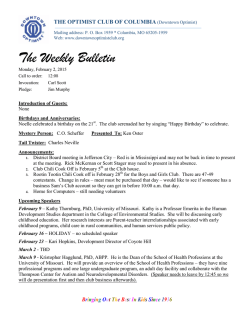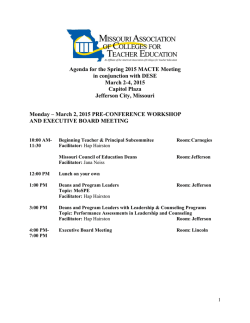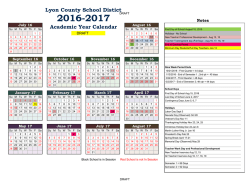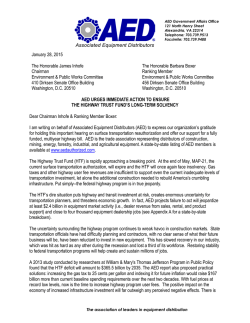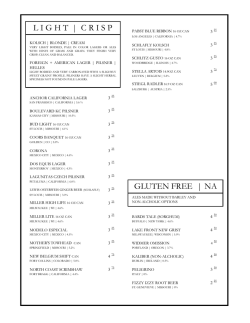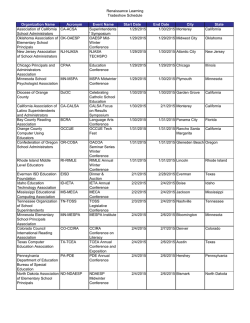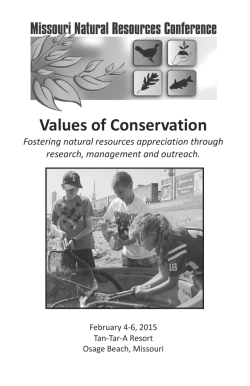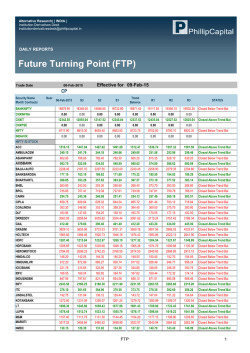
Tracker - Missouri Department of Transportation
KEEP CUSTOMERS AND OURSELVES SAFE (LOHHQ5DFNHUV6WDWH7UDI¿FDQG+LJKZD\6DIHW\(QJLQHHU Tracker M E A S U R E S O F D E PA RT M E N TA L P E R F O R M A N C E Safety is a daily commitment for all MoDOT employees. From design and construction to operations and maintenance of the state transportation system, the safety of our customers, partners, and employees is our top priority. We work with our safety partners to promote safe behavior for all users and modes of transportation so everyone goes home safe every day. 1 RESULT DRIVER: Eileen Rackers, State Traffic and Highway Safety Engineer MEASUREMENT DRIVER: Leanna Depue, Highway Safety Director PURPOSE OF THE MEASURE: The fatal and serious injury number measures track quarterly, annual and fiveyear average trends resulting from traffic crashes on all Missouri roadways. The rate of fatal and serious injury charts display annual and five-year average fatality and injury rates per 100 million vehicle miles traveled for these same crashes. In addition, the fatality rate chart includes the national average. KEEP CUSTOMERS AND OURSELVES SAFE MAP-21 Number and rate of fatalities and serious injuries-1a Keeping travelers safe is one of MoDOT’s highest priorities. Over the last few years, fatalities and serious injuries have experienced a significant decline of 40 percent since 2005. The large decrease is due to safety improvements on Missouri roadways, focused enforcement efforts and educational campaigns that have kept these issues in front of motorists. When compared to the previous year, the 2013 traffic fatality count decreased by 8 percent to a total of 757. The five-year average continued on a downward trend to 814 in 2013. Serious injury data for 2013 reflect a continued downward trend for both the number and five-year average of serious injuries for the eighth straight year. The 2013 fatality rate per 100 million miles traveled fell to the lowest rate on record to 1.09. In 2012, the national fatality rate per 100 million miles traveled was 1.13. As funding levels decline, MoDOT will be challenged to deliver system-wide safety improvements. MEASUREMENT AND DATA COLLECTION: Missouri law enforcement agencies submit a vehicle accident report form to the Missouri State Highway Patrol to enter them into a statewide traffic crash database. The database automatically updates MoDOT’s crash database system, which is called the Transportation Management System. Missouri Department of Transportation 1a KEEP CUSTOMERS AND OURSELVES SAFE Number of Fatalities 1,000 4th Qtr 949 887 821 854 826 814 786 Number 750 500 250 213 258 757 3rd Qtr 756 197 225 203 201 219 204 1st Qtr 227 233 210 196 195 154 133 2010 2011 2nd Qtr 195 205 192 140 146 2012 2013 *YTD 2014 5 year average 0 DESIRED TREND Calendar Year *YTD 2014 – First, second and third quarter fatalities were derived from TMS and fourth quarter fatalities gathered using MSHP radio reports. Rate of Fatalities 1.75 MO 1 year average 1.51 1.50 Number 1.37 1.28 1.27 1.25 MO 5 year average 1.16 1.24 1.18 1.14 1.21 1.15 1.00 1.11 1.1 1.13 2010 2011 2012 1.09 2013 National average 0.75 2009 Calendar Year DESIRED TREND Missouri Department of Transportation 1a2 KEEP CUSTOMERS AND OURSELVES SAFE Number of Serious Injuries 8,000 7,092 6,143 6,096 6,000 5,643 5,506 1,424 1,228 Number 1,483 4,000 1,720 4th Qtr 6,591 1,625 5,749 3rd Qtr 4,939 2nd Qtr 1,276 1st Qtr 1,485 1,370 2,000 1,679 1,521 2,885 985 1,562 1,343 956 1,214 1,073 1,231 950 944 2010 2011 2012 2013 *YTD 2014 5 year average DESIRED TREND 0 Calendar Year DESIRED TREND *YTD 2014 - Due to a backlog of crash reports into STARS, the serious injury measure for the first, second and third quarter 2014 will only illustrate data derived from TMS. Fourth quarter 2014 data is unavailable through the MSHP radio reports. Rate of Serious Injuries 12.00 11.05 10.26 1 year average 9.54 8.91 9.00 8.10 Number 9.47 8.63 8.20 5 year average 8.05 6.00 6.17 3.00 0.00 2009 2010 2011 2012 Calendar Year 2013 DESIRED TREND Missouri Department of Transportation 1a3 RESULT DRIVER: Eileen Rackers, State Traffic and Highway Safety Engineer MEASUREMENT DRIVER: Leanna Depue, Highway Safety Director PURPOSE OF THE MEASURE: The vulnerable roadway user measure tracks annual trends in fatalities and serious injuries of motorcyclists, pedestrians and bicyclists. These roadway users are most at risk for death or serious injury when involved in a motor-vehicle-related crash. KEEP CUSTOMERS AND OURSELVES SAFE Number of vulnerable roadway user fatalities and serious injuries-1b In 2013, vulnerable roadway users were 20 percent of the total number of fatalities. Motorcycle, pedestrian, and bicycle fatalities all decreased in 2013 by 29 percent, 13 percent, and 33 percent respectively. Motorcycle fatalities in 2013 were the lowest since 2004. Serious injury data for 2013 are still incomplete. Motorcycle and bicycle serious injuries are showing a downward trend while pedestrian serious injuries appear to have increased from 2012 to 2013. MEASUREMENT AND DATA COLLECTION: Data is collected by law enforcement and entered into the State Traffic Accident Record System managed by the Missouri State Highway Patrol. The record system automatically updates MoDOT’s Traffic Management System. Missouri Department of Transportation 1b KEEP CUSTOMERS AND OURSELVES SAFE Motorcycle Fatalities & Serious Injuries 688 634 591 500 533 250 102 2010 2011 2012 Serious Inj Fatalities 72 Serious Inj Serious Inj Serious Inj Fatalities 81 Fatalities 93 0 Fatalities Number 750 2013 DESIRED TREND Calendar Year Pedestrian Fatalities & Serious Injuries 302 260 276 268 195 229 130 86 2011 2012 Serious Inj Fatalities Serious Inj Serious Inj 2010 75 Serious Inj 75 57 Fatalities 0 Fatalities 65 Fatalities Number 325 2013 DESIRED TREND Calendar Year Bicycle Fatalities & Serious Injuries 75 73 73 66 50 25 2010 2011 Calendar Year Serious Inj Serious Inj 2012 Fatalities 4 Fatalities Serious Inj Fatalities Serious Inj 0 6 1 14 Fatalities Number 69 2013 DESIRED TREND Missouri Department of Transportation 1b2 RESULT DRIVER: Eileen Rackers, State Traffic and Highway Safety Engineer MEASUREMENT DRIVER: Mike Curtit, Traffic Liaison Engineer PURPOSE OF THE MEASURE: This measure tracks annual trends in motor vehicle related fatal and serious injuries resulting from some of the most common contributing factors or highway features. This data represents six of the top focus areas presented in Missouri’s Blueprint to Save More Lives. MEASUREMENT AND DATA COLLECTION: Missouri law enforcement agencies submit a vehicle crash report form to the Missouri State Highway Patrol to enter them into a statewide traffic crash database. MoDOT staff query and analyze this data to determine the number of unrestrained occupants in crashes, how often aggressive driving, alcohol and other drugs contribute to crashes, and whether or not the vehicles ran off the road, or the crash occurred at an intersection or within a curve. KEEP CUSTOMERS AND OURSELVES SAFE Number of fatalities and serious injuries resulting from the most frequent crash causes-1c Recording and monitoring crash data is an important part of improving safety for Missouri drivers. But without looking at the causes of these incidents, the data is nothing but numbers. Looking for the reasons why an incident occurs is MoDOT’s best approach to address the problem. With that approach, the department finds the most frequent causes continue to be a mix of engineering and behavioral issues. The general trend for both fatalities and serious injuries has declined for the last five years. Comparing the number of fatalities in 2012 to 2013 shows the following results: 16 percent reduction in unrestrained occupants, 9 percent reduction in run-off-road, 8 percent reduction in aggressive driving, 2 percent reduction in alcohol and/or other drugs, 6 percent reduction in curve related, and 26 percent reduction in intersection related. Comparing the number of serious injuries in 2012 to 2013 shows the following results: 14 percent reduction in unrestrained occupants, 13 percent reduction in run-off-road, 8 percent reduction in aggressive driving, 14 percent reduction in alcohol and/or other drugs, 16 percent reduction in curve related, and 4 percent reduction in intersection related. The safety improvements included in the Smooth Roads Initiative and Better Roads, Brighter Future programs began the downward trends in fatalities and serious injuries. With both of these programs complete and without additional resources to invest in additional system-wide safety measures, the downward trends for each of these causes will be difficult to maintain. Significant improvements to increase safety will not be possible with diminishing funding levels predicted in the next few years. The primary current initiatives include adding shoulders and rumble strips to minor roads and striping all major roads prior to Memorial Day. While driver behavior is difficult to correct, MoDOT continues to focus on using funds to target locations and behaviors based on crash data analysis. Missouri Department of Transportation 1c KEEP CUSTOMERS AND OURSELVES SAFE Number of Fatalities 500 Unrestrained Occupants 425 Number 398 392 400 398 395 380 316 374 293 300 400 Run-Off-Road 365 396 335 334 341 262 270 279 308 263 234 244 239 281 132 Alcohol and/or Other Drugs Curves 240 200 Aggressive Driving 142 Intersection Crashes 136 119 100 100 2009 2010 2011 2012 2013 DESIRED TREND Calendar Year Number of Serious Injuries 3,000 Unrestrained Occupants 2,692 2,543 Run-Off-Road 2,362 2,312 2,273 2,269 2,250 Number 1,988 1,983 1,886 1,783 1,739 1,500 1,743 1,636 1,605 1,703 1,521 1,486 1,449 1,452 1,142 1,340 964 945 912 Alcohol and/or Other Drugs Curves 1,484 1,598 Aggressive Driving 1,283 1,245 1,241 Intersection Crashes 788 750 2009 2010 2011 Calendar Year 2012 2013 DESIRED TREND Missouri Department of Transportation 1c2 RESULT DRIVER: Eileen Rackers, State Traffic and Highway Safety Engineer MEASUREMENT DRIVER: Julie Stotlemeyer, Traffic Liaison Engineer PURPOSE OF THE MEASURE: An important factor in evaluating the safety of Missouri’s transportation system includes the safety of work zones on the state’s roadway system. This measure tracks the number of traffic-related and non-traffic related fatalities, injuries and overall crashes occurring in work zones on state-owned roadways. KEEP CUSTOMERS AND OURSELVES SAFE Number of fatalities and serious injuries in work zones-1d Work zone safety is at the center of MoDOT’s safety culture. It is a driving force in all maintenance and construction work. Just as MoDOT expects its crews to be safe and visible, it also expects contractors to provide safe work zones and visible workers. This is demonstrated by the partnership MoDOT has with contractors using the same personal protection equipment it uses. Staying safe in work zones is also a partnership the department shares with the driving public. MoDOT wants everyone to get home safely. While MoDOT makes every effort to work safely, it is counting on motorists to pay attention, slow down and move over. For crash reports entered to date for calendar year 2014, Missouri work zones have experienced seven fatalities and 29 serious injuries. Fifty percent of the work zone fatalities were unbuckled. MEASUREMENT AND DATA COLLECTION: Missouri law enforcement agencies submit a vehicle accident report form to the Missouri State Highway Patrol to enter them into a statewide traffic crash database. MoDOT staff query and analyze this data to identify work zone related crash statistics. MSHP prioritizes entry of the crash reports by fatality, serious injury, minor injury and then property damage only. Currently MSHP is entering minor injury and property damage only crash reports for May 2014. Therefore, the numbers for these types of crashes will continue to change for calendar year 2014. Missouri Department of Transportation 1d KEEP CUSTOMERS AND OURSELVES SAFE Number of Fatalities in Work Zones 20 50 4th Qtr 40 3rd Qtr Number 15 14 2 28th 10 30 24th 10 5 8 7 4 7 1 5 4 1 2 6 4 4 3 2 2 2 2010 2011 2012 2013 20 10 National Ranking 41st 2nd Qtr 1st Qtr National Ranking (1st = Best) 4 0 0 *YTD 2014 Calendar Year DESIRED TREND Number of Crashes in Work Zones 2,400 2,053 Number 1,800 1,200 600 0 4th Qtr 443 694 1,388 1,449 1,509 3rd Qtr 288 344 339 2nd Qtr 493 475 512 1st Qtr 427 639 453 435 437 277 154 195 221 156 165 106 2010 2011 2012 2013 *YTD 2014 Calendar Year DESIRED TREND *YTD 2014 – First, second, third and fourth quarter fatalities were derived from TMS. Due to a backlog of crash reports into STARS, the serious, minor injury and work zone crash measures will only illustrate data derived from TMS for first, second and third quarters. Fourth quarter TMS data incomplete. Missouri Department of Transportation 1d2 KEEP CUSTOMERS AND OURSELVES SAFE Number of Serious Injuries in Work Zones 90 83 4th Qtr Number 17 56 60 3rd Qtr 56 2nd Qtr 6 30 18 30 19 30 26 5 5 11 8 6 2012 2013 18 30 13 0 6 7 2010 2011 1st Qtr 29 10 17 2 *YTD 2014 Calendar Year DESIRED TREND Number of Minor Injuries in Work Zones Number 900 792 4th Qtr 153 3rd Qtr 600 313 474 2nd Qtr 403 97 111 167 150 156 167 96 54 71 113 52 2010 2011 2012 2013 300 230 0 499 1st Qtr 81 157 Calendar Year 31 151 60 60 *YTD 2014 DESIRED TREND *YTD 2014 – Due to a backlog of crash reports into STARS, the serious, minor injury and work zone crash measures for the first, second and third quarters of 2014 will only illustrate data derived from TMS. Fourth quarter 2014 data is unavailable through the MSHP radio reports. Missouri Department of Transportation 1d3 Percent of Safety Belt/Passenger Vehicle Restraint Use 20 30 41st 25 39th 50 40 0 National Ranking 78.8 75.9 89.0 10 80.1 79.7 79.0 88.8 77.3 75 Nationwide Primary States 0 100 91.8 Each June, a statewide survey is conducted at 560 pre-selected locations in 28 counties. The data collected is calculated into a safety belt usage rate using a formula approved by the National Highway Traffic Safety Administration. The safety belt usage survey collects data from locations representing 85 percent of the state’s vehicle occupant fatalities. The data collection plan is the same each year for consistency and compliance with National Highway Traffic Safety Administration guidelines. Missouri’s safety belt use has plateaued. The number of states with a primary safety belt use law, result in a higher rate of use for those states. States that have a secondary law continue to fall down the list in the national rankings. 79.0 MEASUREMENT AND DATA COLLECTION: Safety belt use in Missouri for 2014 was 79 percent. The national average for safety belt use in 2013 was 87 percent. Missouri’s national ranking is currently 41st. Only nine states rank lower in safety belt use than Missouri. 43rd This measure tracks annual trends in safety belt use in passenger vehicles. This data drives the development and focus of the Missouri Highway Safety Plan, which is required annually by the National Highway Traffic Safety Administration. In addition, this data supports Missouri’s Blueprint to Save More Lives that identifies the statewide initiatives with a goal of reducing fatalities to 700 or fewer by 2016. 81.2 PURPOSE OF THE MEASURE: Safety belts save lives. But getting people to use them – even to protect their own lives – is a challenge. Public education is one way to keep the issue in front of motorists. Legislation is another. MoDOT supports both approaches, attacking the problem with focused marketing campaigns and reinforcing it with hard facts to back legislative efforts. Several municipalities across the state are taking matters into their own hands enacting primary ordinances within city limits. Missouri currently has 44 communities with a primary safety belt ordinance representing 21.6 percent of the state’s population. 89.0 Bill Whitfield, Highway Safety Program Administrator Percent of safety belt/passenger vehicle restraint use-1e 76.0 MEASUREMENT DRIVER: KEEP CUSTOMERS AND OURSELVES SAFE 46th Eileen Rackers, State Traffic and Highway Safety Engineer Percent RESULT DRIVER: Missouri Nationwide Secondary States National Ranking (1st = Best) 50 2010 2011 2012 Calendar Year 2013 2014 DESIRED TREND Missouri Department of Transportation 1e RESULT DRIVER: Eileen Rackers, State Traffic and Highway Safety Engineer MEASUREMENT DRIVER: Mark Biesemeyer, Motor Carrier Services Program Manager PURPOSE OF THE MEASURE: This measure tracks the number of Commercial Motor Vehicles involved in fatal and serious injury crashes each year. MoDOT uses the information to target educational, enforcement and improvement of safety feature efforts. MEASUREMENT AND DATA COLLECTION: Missouri law enforcement agencies submit a vehicle accident report form to the Missouri State Highway Patrol to enter them into a statewide traffic crash database. The measure reports the number of CMVs involved in crashes in which one or more people are seriously injured or die as a result of the crash. Preliminary results for the current year are reported quarterly. KEEP CUSTOMERS AND OURSELVES SAFE Number of commercial motor vehicle crashes resulting in fatalities and serious injuries-1f Commercial Motor Vehicles are the lifeblood of our economy. They transport the goods and materials that keep the nation moving. Partnering with the Missouri State Highway Patrol and St. Louis and Kansas City police departments, MoDOT does everything in its power to keep CMV drivers safe and their vehicles on the road. By tracking the number of CMV crashes resulting in fatalities and serious injuries, the department can target educational and enforcement efforts, and also improve safety features such as highway signs, reflective pavement markings, guard cables, rumble strips and incident management alert signs. These efforts are making a difference in the number of fatality and serious injury crashes. Between 2010 and 2013, fatal crashes involving a CMV decreased by 13.7 percent. However, the number of fatal crashes reported through the third quarter of 2014 is 69, which is 10 more than reported for through the third quarter of 2013, or a 16.9 percent increase. Between 2010 and 2013, CMV serious injury crashes decreased by 15.5 percent. The number of serious injury crashes reported through the third quarter of 2014 is 199, which is 27 less than reported for through the third quarter of 2013, or a decrease of 11.9 percent. However, diminished funding may hamper the department’s ability to make significant safety improvements in the future. Missouri Department of Transportation 1f KEEP CUSTOMERS AND OURSELVES SAFE Number of Commercial Motor Vehicle Crashes Resulting in Fatalities 4th Qtr 50 200 38th Number 150 100 107 104 36 27 21 27 28 22 16 22 28 2010 2011 2012 95 30 24 0 40 33rd 25 50 37th 30 82 69 23 20 28 28 National Ranking 3rd Qtr 2nd Qtr 1st Qtr National Ranking (1st = Best) 10 25 18 13 16 2013 *YTD 2014 0 Calendar Year DESIRED TREND Number of Commercial Motor Vehicle Crashes Resulting in Serious Injuries 400 373 4th Qtr 347 100 Number 300 84 294 71 93 200 96 100 315 3rd Qtr 89 2nd Qtr 199 107 81 85 90 71 73 66 1st Qtr 68 84 75 67 63 65 2010 2011 2012 2013 *YTD 2014 0 Calendar Year DESIRED TREND *2014 - Due to a backlog of crash reports into STARS, the fatality and serious injury measures for the third quarter of 2014 will only illustrate data derived from TMS. Missouri Department of Transportation 1f2 Eileen Rackers, State Traffic and Highway Safety Engineer MEASUREMENT DRIVER: Roberta Jacobson, Claims Administration Manager PURPOSE OF THE MEASURE: This measure tracks the actual number of days employees cannot work due to work-related injuries. MEASUREMENT AND DATA COLLECTION: The data is collected from Riskmaster, the department’s risk management claims administration software. KEEP CUSTOMERS AND OURSELVES SAFE Number of lost workdays-1g The impact of work-related injuries cannot be underestimated. Employees injured at work not only affect the department, but can disrupt the personal lives of MoDOT employees and their families. Measuring lost workdays shows more than a number on a chart. These are people whose lives can be changed by a split second of inattention or poor preparation. Watching this number fall over the years, shows that something is going right. For 2014, the total number of lost workdays decreased 17 percent from 2013. There were three incidents in which employees fell or slipped on MoDOT equipment, accounting for 20 percent of the lost workdays. Another 18 percent of the lost workdays were attributable to three incidents involving snow or ice conditions. Two incidents of lifting MoDOT equipment or materials accounted for 11 percent of the lost workdays. Employees are paying attention. They are wearing proper safety gear and taking proper precautions before engaging in a safety-sensitive task. The drop in this number is more than a statistic. It means more people are going home safe. Number of Lost Workdays 1,793 1,800 1,704 1,289 Injury Occurred Prior to Current Year 984 1,200 1,284 Number RESULT DRIVER: 932 649 769 Injury Occurred During Current Year 451 272 600 809 640 420 481 497 2012 2013 2014 0 2010 2011 Calendar Year DESIRED TREND Missouri Department of Transportation 1g RESULT DRIVER: Eileen Rackers, State Traffic and Highway Safety Engineer MEASUREMENT DRIVER: Jeff Padgett, Risk and Benefits Management Director PURPOSE OF THE MEASURE: This measure tracks the number of recordable injuries, in total and as a rate of injuries per 100 workers. MEASUREMENT AND DATA COLLECTION: KEEP CUSTOMERS AND OURSELVES SAFE Total and rate of MoDOT recordable incidents-1h MoDOT is dedicated to employee safety. Getting home safe is a responsibility every employee shares. To reinforce this value, the “Safety Begins with Me” program was launched in 2013 to remind all employees that safety is a personal responsibility. Both the number of recordable incidents and the rate of recordable incidents have increased for 2014 compared to 2013. Leading causes of incidents during calendar year 2014 were: slips, trips and falls at 25 percent; strains (lifting, twisting, pushing/pulling) at 15 percent; struck or injured and cut/ puncture at 12 percent each. When looking at the largest category (slips, trips and falls), 37 percent of these injuries were snow/ice related. Another 27 percent occurred when employees were entering, exiting or climbing on MoDOT equipment. The calculation for incidence rate is the number of recordables times 200,000 divided by the number of hours worked. The 200,000 used in the calculation is the base for 100 full-time workers (working 40 hours per week, 50 weeks per year). MoDOT defines a recordable incident as a workrelated injury or illness that results in death, days away from work or medical treatment resulting in cost to the department. The injury data is collected from Riskmaster, the department’s risk management claims administration software. The number of hours worked is taken from MoDOT’s payroll data. Missouri Department of Transportation 1h KEEP CUSTOMERS AND OURSELVES SAFE Total of MoDOT Recordable Incidents 350 332 Number 280 295 266 272 2012 2013 286 210 140 70 0 2010 2011 2014 DESIRED TREND Calendar Year Rate of MoDOT Recordable Incidents 6 Frequency Rate 5 5.00 4.90 4.80 4.91 5.05 Texas DOT* 4 Rate 4.00 3.90 3.70 Private Industry Construction* 3 2 2.58 2.29 2.01 1 0 2010 2011 2012 Calendar Year 2013 2014 DESIRED TREND *Texas DOT and Private Industry Construction category data, from the OSHA website, are not yet available for 2013. Missouri Department of Transportation 1h2 RESULT DRIVER: Eileen Rackers, State Traffic and Highway Safety Engineer MEASUREMENT DRIVER: KEEP CUSTOMERS AND OURSELVES SAFE General liability claims and costs-1i This measure tracks the number of general liability claims filed and amount paid. Keeping ourselves and the public safe is MoDOT’s top priority. Controlling damage to vehicles and reducing personal injury in work zones, right of way and other areas under department control helps MoDOT accomplish this goal. Compared to 2013, there was a decrease of 4 percent in the number of claims. For 2014, the majority of the claims are attributed to striping and pavement defects. During the same timeframe, there was a decrease of 5 percent in the amount paid. This quarter, payment was made on 115 claims against the department totaling $2,126,999.52. More than 75 percent of this quarter’s payments are attributed to three claims. MEASUREMENT AND DATA COLLECTION: The department received an unfavorable arbitration on a claim occurring in 2009, costing $813,852, where MoDOT was found to have a dangerous condition at an intersection. The accident resulted in severe injuries to two claimants. Steve Patterson, Safety and Claims Manager PURPOSE OF THE MEASURE: General liability claims arise from allegations of injuries/damages caused by the dangerous condition of MoDOT property and the injury/damage directly resulted from the dangerous condition. In addition, an employee must be negligent and create the dangerous condition or MoDOT must have actual or constructive notice of the dangerous condition in sufficient time prior to the injury/damage to have taken measures to protect the public against the dangerous condition. Claims data is collected from Riskmaster, the department’s risk management claims administration software. The department received an unfavorable arbitration on a another claim occurring in 2009, costing $743,000, The accident occurred on ice covered road due to drainage from piled up snow on the shoulder. As a result there was a single car accident causing a fatality to a pedestrian. The department settled a claim occurring in 2014 for $295,000, based on the dangerous condition of a lettered route where there was a significant edge drop-off. This contributed to multiple injuries and one fatality. Missouri Department of Transportation 1i KEEP CUSTOMERS AND OURSELVES SAFE Number of Claims for General Liability 1,500 1,387 Number 1,000 997 859 824 2013 2014 699 500 0 2010 2011 2012 Calendar Year DESIRED TREND Amount Paid in Claims for General Liability Dollars (in thousands) 12,000 9,000 10,066 8,912 8,730 2012 2013 8,328 6,000 5,878 3,000 0 2010 2011 2014 Calendar Year DESIRED TREND Missouri Department of Transportation 1i2
© Copyright 2025

